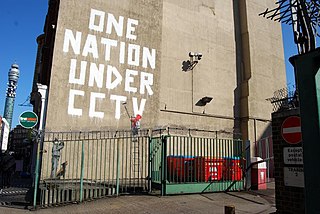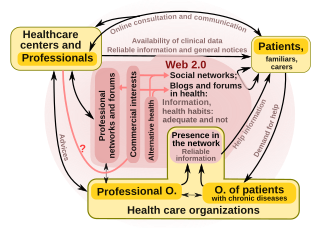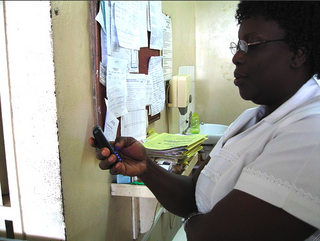
Privacy is the ability of an individual or group to seclude themselves or information about themselves, and thereby express themselves selectively.
Public health surveillance is, according to the World Health Organization (WHO), "the continuous, systematic collection, analysis and interpretation of health-related data needed for the planning, implementation, and evaluation of public health practice." Public health surveillance may be used to track emerging health-related issues at an early stage and find active solutions in a timely manner. Surveillance systems are generally called upon to provide information regarding when and where health problems are occurring and who is affected.

Disease surveillance is an epidemiological practice by which the spread of disease is monitored in order to establish patterns of progression. The main role of disease surveillance is to predict, observe, and minimize the harm caused by outbreak, epidemic, and pandemic situations, as well as increase knowledge about which factors contribute to such circumstances. A key part of modern disease surveillance is the practice of disease case reporting.

GISAID, the Global Initiative on Sharing All Influenza Data, previously the Global Initiative on Sharing Avian Influenza Data, is a global science initiative established in 2008 to provide access to genomic data of influenza viruses. The database was expanded to include the coronavirus responsible for the COVID-19 pandemic, as well as other pathogens. The database has been described as "the world's largest repository of COVID-19 sequences". GISAID facilitates genomic epidemiology and real-time surveillance to monitor the emergence of new COVID-19 viral strains across the planet.
Tele-epidemiology is the application of telecommunications to epidemiological research and application, including space-based and internet-based systems.

"Health 2.0" is a term introduced in the mid-2000s, as the subset of health care technologies mirroring the wider Web 2.0 movement. It has been defined variously as including social media, user-generated content, and cloud-based and mobile technologies. Some Health 2.0 proponents see these technologies as empowering patients to have greater control over their own health care and diminishing medical paternalism. Critics of the technologies have expressed concerns about possible misinformation and violations of patient privacy.

mHealth is an abbreviation for mobile health, a term used for the practice of medicine and public health supported by mobile devices. The term is most commonly used in reference to using mobile communication devices, such as mobile phones, tablet computers and personal digital assistants (PDAs), and wearable devices such as smart watches, for health services, information, and data collection. The mHealth field has emerged as a sub-segment of eHealth, the use of information and communication technology (ICT), such as computers, mobile phones, communications satellite, patient monitors, etc., for health services and information. mHealth applications include the use of mobile devices in collecting community and clinical health data, delivery/sharing of healthcare information for practitioners, researchers and patients, real-time monitoring of patient vital signs, the direct provision of care as well as training and collaboration of health workers.
Reality mining is the collection and analysis of machine-sensed environmental data pertaining to human social behavior, with the goal of identifying predictable patterns of behavior. In 2008, MIT Technology Review called it one of the "10 technologies most likely to change the way we live."
Urban computing is an interdisciplinary field which pertains to the study and application of computing technology in urban areas. This involves the application of wireless networks, sensors, computational power, and data to improve the quality of densely populated areas. Urban computing is the technological framework for smart cities.
The social data revolution is the shift in human communication patterns towards increased personal information sharing and its related implications, made possible by the rise of social networks in the early 2000s. This phenomenon has resulted in the accumulation of unprecedented amounts of public data.
Infoveillance is a type of syndromic surveillance that specifically utilizes information found online. The term, along with the term infodemiology, was coined by Gunther Eysenbach to describe research that uses online information to gather information about human behavior.

Google Flu Trends (GFT) was a web service operated by Google. It provided estimates of influenza activity for more than 25 countries. By aggregating Google Search queries, it attempted to make accurate predictions about flu activity. This project was first launched in 2008 by Google.org to help predict outbreaks of flu.
The United Nations Global Pulse is an initiative of the United Nations that attempts to "bring real-time monitoring and prediction to development and aid programs."
Azumio is a mobile health company that specializes in biometric mobile technology. Founded in 2011, Azumio develops Apple iOS and Android health apps and services. Azumio has released 24 apps on iOS, 5 apps on Android, and 3 apps on Windows Phone. The company is headquartered in Palo Alto, California.
Participatory surveillance is community-based monitoring of other individuals. This term can be applied to both digital media studies and ecological field studies. In the realm of media studies, it refers to how users surveil each other using the internet. Either through the use of social media, search engines, and other web-based methods of tracking, an individual has the power to find information both freely or non freely given about the individual being searched. Issues of privacy emerge within this sphere of participatory surveillance, predominantly focused on how much information is available on the web that an individual does not consent to. More so, disease outbreak researchers can study social-media based patterns to decrease the time it takes to detect an outbreak, an emerging field of study called infodemiology. Within the realm of ecological fieldwork, participatory surveillance is used as an overarching term for the method in which indigenous and rural communities are used to gain greater accessibility to causes of disease outbreak. By using these communities, disease outbreak can be spotted earlier than through traditional means or healthcare institutions.
An infodemic is a rapid and far-reaching spread of both accurate and inaccurate information about certain issues. The word is a portmanteau of "information" and "epidemic" and is used as a metaphor to describe how misinformation and disinformation can spread like a virus from person to person and affect people like a disease. This term, originally coined in 2003 by David Rothkopf, rose to prominence in 2020 during the COVID-19 pandemic.

Caroline O'Flaherty Buckee is an epidemiologist. She is an associate professor of Epidemiology and is the associate director of the Center for Communicable Disease Dynamics, both at the Harvard T.H. Chan School of Public Health. Buckee is known for her work in digital epidemiology, where mathematical models track mobile and satellite data to understand the transmission of infectious diseases through populations in an effort to understand the spatial dynamics of disease transmission. Her work examines the implications of conducting surveillance and implementing control programs as a way to understand and predict what will happen when dealing with outbreaks of infectious diseases like malaria and COVID-2019.
Data collaboratives are a form of collaboration in which participants from different sectors—including private companies, research institutions, and government agencies—can exchange data and data expertise to help solve public problems.

Mobile positioning data (MPD) is a form of big datawhich results from the high data volumes of mobile positioning – tracking the location of mobile phones.

Rumi Chunara is a computer scientist who is an associate professor of biostatistics at the New York University School of Global Public Health. She develops computational and statistical approaches to acquire, integrate and make use of data improve population-level public health.








